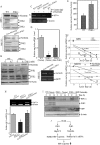The requirement of c-Jun N-terminal kinase 2 in regulation of hypoxia-inducing factor-1α mRNA stability
- PMID: 22910906
- PMCID: PMC3464542
- DOI: 10.1074/jbc.M112.365882
The requirement of c-Jun N-terminal kinase 2 in regulation of hypoxia-inducing factor-1α mRNA stability
Abstract
The mRNA of hif-1α is considered as being constitutively and ubiquitously expressed, regardless of the level of oxygen tension. However many recent reports have showed that hif-1α mRNA could be regulated by natural antisense transcripts, potential microRNAs, and low O(2). In this study, it was found that a deficiency of JNK2 expression reduced HIF-1α protein induction in response to nickel treatment resulting from the impaired expression of hif-1α mRNA. Both the promoter luciferase assay and mRNA degradation assay clearly showed that depletion of JNK2 affected stability of hif-1α mRNA, rather than regulated its transcription. In addition, nucleolin, a classic histone chaperone, was demonstrated to physically bind to hif-1α mRNA and maintain its stability. Further investigation indicated that JNK2 regulated nucleolin expression and might in turn stabilize hif-1α mRNA. Collectively, we provided one more piece of evidence for the oncogenic role of JNK2 and nucleolin in regulating the cancer microenvironments by controlling HIF-1α expression.
Figures





Similar articles
-
JNK2 up-regulates hypoxia-inducible factors and contributes to hypoxia-induced erythropoiesis and pulmonary hypertension.J Biol Chem. 2018 Jan 5;293(1):271-284. doi: 10.1074/jbc.RA117.000440. Epub 2017 Nov 8. J Biol Chem. 2018. PMID: 29118187 Free PMC article.
-
Docetaxel induced-JNK2/PHD1 signaling pathway increases degradation of HIF-1α and causes cancer cell death under hypoxia.Sci Rep. 2016 Jun 6;6:27382. doi: 10.1038/srep27382. Sci Rep. 2016. PMID: 27263528 Free PMC article.
-
Hypoxia upregulates hypoxia inducible factor (HIF)-3alpha expression in lung epithelial cells: characterization and comparison with HIF-1alpha.Cell Res. 2006 Jun;16(6):548-58. doi: 10.1038/sj.cr.7310072. Cell Res. 2006. PMID: 16775626
-
cDNA cloning, gene organization and variant specific expression of HIF-1 alpha in high altitude yak (Bos grunniens).Gene. 2007 Jan 15;386(1-2):73-80. doi: 10.1016/j.gene.2006.08.004. Epub 2006 Aug 23. Gene. 2007. PMID: 17045424
-
Regulation of HIF-1alpha at the transcriptional level.Curr Pharm Des. 2009;15(33):3844-52. doi: 10.2174/138161209789649420. Curr Pharm Des. 2009. PMID: 19671046 Review.
Cited by
-
p85α promotes nucleolin transcription and subsequently enhances EGFR mRNA stability and EGF-induced malignant cellular transformation.Oncotarget. 2016 Mar 29;7(13):16636-49. doi: 10.18632/oncotarget.7674. Oncotarget. 2016. PMID: 26918608 Free PMC article.
-
JNK2 up-regulates hypoxia-inducible factors and contributes to hypoxia-induced erythropoiesis and pulmonary hypertension.J Biol Chem. 2018 Jan 5;293(1):271-284. doi: 10.1074/jbc.RA117.000440. Epub 2017 Nov 8. J Biol Chem. 2018. PMID: 29118187 Free PMC article.
-
A novel post-translational modification of nucleolin, SUMOylation at Lys-294, mediates arsenite-induced cell death by regulating gadd45α mRNA stability.J Biol Chem. 2015 Feb 20;290(8):4784-4800. doi: 10.1074/jbc.M114.598219. Epub 2015 Jan 5. J Biol Chem. 2015. PMID: 25561743 Free PMC article.
-
SOX2 Promotes Invasion in Human Bladder Cancers through MMP2 Upregulation and FOXO1 Downregulation.Int J Mol Sci. 2022 Oct 19;23(20):12532. doi: 10.3390/ijms232012532. Int J Mol Sci. 2022. PMID: 36293387 Free PMC article.
-
Nucleolin is important for Epstein-Barr virus nuclear antigen 1-mediated episome binding, maintenance, and transcription.Proc Natl Acad Sci U S A. 2014 Jan 7;111(1):243-8. doi: 10.1073/pnas.1321800111. Epub 2013 Dec 16. Proc Natl Acad Sci U S A. 2014. PMID: 24344309 Free PMC article.
References
-
- Grandjean P. (1984) Human exposure to nickel. IARC. Sci. Publ. 53, 469–485 - PubMed
-
- Furst A. (1984) Mechanism of action of nickel as a carcinogen: needed information. IARC. Sci. Publ. 53, 245–252 - PubMed
-
- Lu H., Shi X., Costa M., Huang C. (2005) Carcinogenic effect of nickel compounds. Mol. Cell. Biochem. 279, 45–67 - PubMed
-
- Ke Q., Costa M. (2006) Hypoxia-inducible factor-1 (HIF-1). Mol. Pharmacol. 70, 1469–1480 - PubMed
Publication types
MeSH terms
Substances
Grants and funding
LinkOut - more resources
Full Text Sources
Research Materials
Miscellaneous

